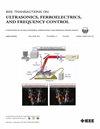Machine Learning-Enhanced Skull-Universal Acoustic Hologram for Efficient Transcranial Ultrasound Neuromodulation Across Varied Rodent Skulls
IF 3
2区 工程技术
Q1 ACOUSTICS
IEEE transactions on ultrasonics, ferroelectrics, and frequency control
Pub Date : 2024-12-02
DOI:10.1109/TUFFC.2024.3506913
引用次数: 0
Abstract
Ultrasound neuromodulation (UNM) has gained significant interest in brain science due to its noninvasive nature, precision, and deep brain stimulation capabilities. However, the skull poses challenges along the acoustic path, leading to beam distortion and necessitating effective acoustic aberration correction. Acoustic holograms used with single-element ultrasound transducers offer a promising solution by enabling both aberration correction and multifocal stimulation. A major limitation, however, is that hologram lenses designed for specific skulls may not perform well on other skulls, requiring multiple custom lenses for scaled studies. To address this, we introduce the skull-universal acoustic hologram (SUAH), which enables efficient transcranial UNM across various skull types. Our hologram generation framework integrates a physics-based acoustic hologram, differentiable acoustic simulation in heterogeneous media, and a gradient accumulation technique. SUAH, trained on a range of rodent skull shapes, demonstrated remarkable generalizability and robustness, even outperforming the skull-specific acoustic hologram (SSAH). Through comprehensive analyses, we showed that SUAH performs exceptionally well—even when trained on smaller datasets—significantly outperforming training based on individual skulls. In conclusion, SUAH shows promise as a scalable, versatile, and accurate tool for UNM, representing a significant advancement over conventional single-skull hologram lenses. Its ability to adapt to different skull types without the need for multiple custom lenses has the potential to greatly facilitate research in UNM.求助全文
约1分钟内获得全文
求助全文
来源期刊
CiteScore
7.70
自引率
16.70%
发文量
583
审稿时长
4.5 months
期刊介绍:
IEEE Transactions on Ultrasonics, Ferroelectrics and Frequency Control includes the theory, technology, materials, and applications relating to: (1) the generation, transmission, and detection of ultrasonic waves and related phenomena; (2) medical ultrasound, including hyperthermia, bioeffects, tissue characterization and imaging; (3) ferroelectric, piezoelectric, and piezomagnetic materials, including crystals, polycrystalline solids, films, polymers, and composites; (4) frequency control, timing and time distribution, including crystal oscillators and other means of classical frequency control, and atomic, molecular and laser frequency control standards. Areas of interest range from fundamental studies to the design and/or applications of devices and systems.

 求助内容:
求助内容: 应助结果提醒方式:
应助结果提醒方式:


